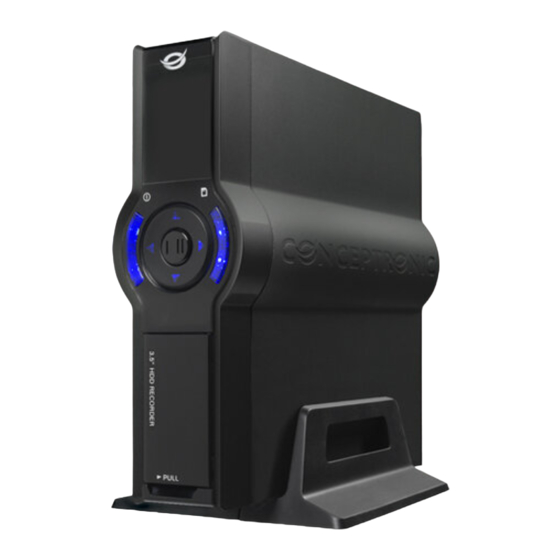Conceptronic CM3PVR Manual del usuario - Página 5
Navegue en línea o descargue pdf Manual del usuario para Reproductor multimedia Conceptronic CM3PVR. Conceptronic CM3PVR 10 páginas. Dvd playback & avi
También para Conceptronic CM3PVR: Cómo hacerlo (4 páginas), Instrucciones (3 páginas), Instrucciones de actualización del firmware (10 páginas)

Once finished, you can rename the channels up to 4 characters,
disable channels you don‟t want or reactivate disabled channels,
change audio format (the usual PAL and NTSC settings), fine-tune
the channels and swap places to end up with a list of channels
arranged as you want them to be.
Up to the part of scanning channels, things are quite easy. Troubles
start once you change audio settings and re-arrange channels. The
swap system is nowhere near as easy as the ability to just select a
channel and move it where it belongs.
How the swapping works is almost as hard to explain as it is to use.
In the "Channel Number" field you enter the channel which you
would like to move and then enter the number for the channel to
swap with in the "Swap Channel" field. Nowhere, is there a list to
use as an overview and that‟s just not convenient at all. This could
have been so much easier with little eye for detail and convenience.
Naming and placing your channels in order is a time-consuming
endeavor. As a side note, it‟s a pity that you have to input the
channels you want to edit with the numeric keys, channel up/down
doesn‟t work in this particular section. It‟s quite a big job, but hey,
you only have to do it once, hopefully.
RECORDING AND ITS FUNCTIONS
Now, we have good news. The Conceptronic CM3PVR does not
record in TS (it is not capable of playing these either) or in the usual
MPEG (mpg, VOB) files. It actually records in Xvid format (720x576,
VBR). This results in less disk space used for your recordings. If we
compare recordings against MPEG recording in high quality, the
CM3PVR records 1 minute below 35MB while the KiSS records at a
rate of 65MB for 1 minute.
The device is able to record to the internal hard disk, USB or
memory card (mind the FAT32 is mandatory and preferably the use
of High Speed Memory Cards).
Recording has 3 quality settings: HQ, SP and LP. HQ recording takes
up approx 2,2GB/hour, SP 1,1GB/hour and LP 0,7GB/hour. The
internal HDD is formatted in FAT32. The device can‟t read/write
NTFS. This is a shame because when using external hard disks or
USB sticks, they all need to be formatted in FAT32. Due to the
FAT32 file system it is not possible to store files larger than 4GB.
A flaw in this system of using XVID would mean however you have
to convert the XVID files first to MPEG stream to make a DVD out of
it but that kind of reasoning counts for other players as well, if we
turn things around where you‟d prefer compressed Xvid or DiVX.
Maximum file size of a recording is 2GB. In HQ mode this means
about 56 minutes of recording. When recording longer programs the
recording will be split into two or more files. This is in my humble
opinion a big flaw. NTFS should have been used to overcome this.
This also raises the question why the files are cut at 2GB when the
system supports 4GB?
numbered file with no indication of the content or files belonging
together. I feel at least a few enhancements could be made to this
The next burden is the
way Conceptronic names
the
files.
Off
course,
missing the EPG functions
and the PDC functions, it
cannot get the names of
the recordings anywhere.
Instead, recordings are
stored with the Time and
Date these took place
resulting in a lengthy
